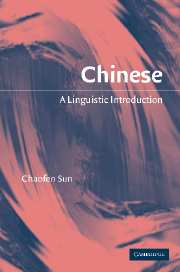Book contents
- Frontmatter
- Contents
- List of maps
- List of tables
- List of figures
- Preface
- Major chronological divisions of Chinese history
- Major periods of the Chinese language
- Introduction
- 1 Historical background of the language
- 2 Phonetics of standard Chinese
- 3 Chinese morphology 1
- 4 Chinese morphology 2
- 5 Chinese writing
- 6 Chinese language and culture
- 7 Chinese syntax 1
- 8 Chinese syntax 2
- Appendix 1 Phonetic symbols
- Appendix 2 Capitalized abbreviations
- References
- Index
3 - Chinese morphology 1
Published online by Cambridge University Press: 05 September 2012
- Frontmatter
- Contents
- List of maps
- List of tables
- List of figures
- Preface
- Major chronological divisions of Chinese history
- Major periods of the Chinese language
- Introduction
- 1 Historical background of the language
- 2 Phonetics of standard Chinese
- 3 Chinese morphology 1
- 4 Chinese morphology 2
- 5 Chinese writing
- 6 Chinese language and culture
- 7 Chinese syntax 1
- 8 Chinese syntax 2
- Appendix 1 Phonetic symbols
- Appendix 2 Capitalized abbreviations
- References
- Index
Summary
Morphology is the study of words and word-making. Its goal is to understand the meaning in the relationships between words and the ways in which they are expressed, including how grammatical relationships are marked in different languages. For example, plurality is explicitly marked by an -s on English nouns, e.g., book as a singular noun and books as a plural noun. Furthermore, the relationships between words may require some morphological changes in different parts of a sentence. For instance, the verb form varies depending on the person and number of the subject noun phrase in an English sentence such as This book is very interesting vs. These books are very interesting in which the subjects and verbs have an agreement relationship, i.e., a third-person singular, subjective noun corresponds to the copular verb is and a third-person plural subjective noun to a different copular verb are.
Cross-linguistically, the minimal unit of meaning is commonly called a morpheme, and it is subdivided into two major types, bound and free. Bound morphemes primarily refer to affixes such as the English plural marker -s which only makes sense when attached to a nominal stem. Alternatively, a noun like book is called a free morpheme because it makes sense all by itself and refers to something in the real world, or is called a stem for an affix to be attached to.
- Type
- Chapter
- Information
- ChineseA Linguistic Introduction, pp. 45 - 74Publisher: Cambridge University PressPrint publication year: 2006

